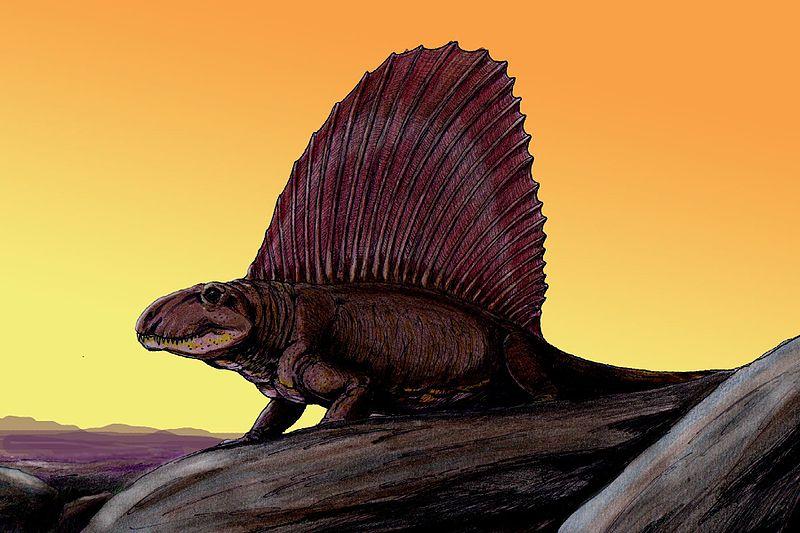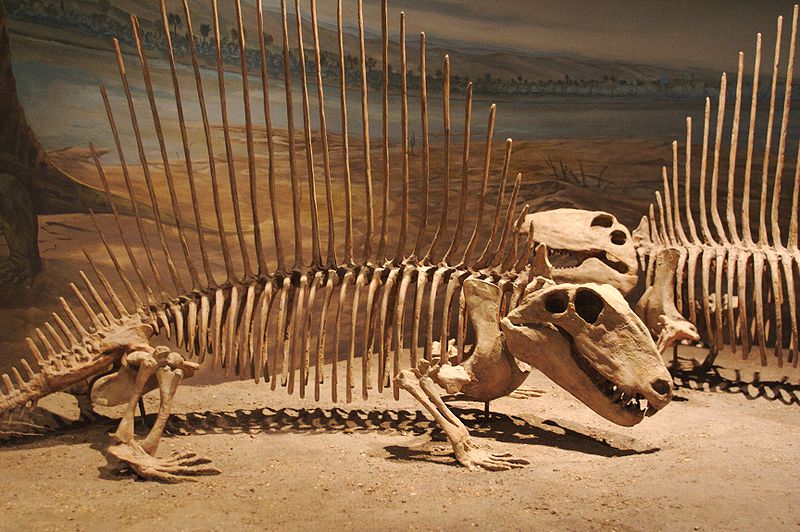Sail
The most
distinctive characteristic of Dimetrodon
was the spectacular sail on its back (other pelycosaurs such as
Edaphosaurus,
Ianthasaurus, and
Sphenacodon also had this anatomical feature). The sail, which may have been supplied
with numerous blood vessels, may have been used to regulate body
temperature; the extra surface area provided by the sail may have allowed
the animal to warm up or cool off more rapidly than without a sail. This
adaptation might have been important because it would have given the animal
a head start over its prey in the morning, thus providing more time to hunt
cooler, slower prey. The sail may also have been used as a display in mating
rituals and to warn off other predators. The sail was supported by
neural spines, each one
sprouting from an individual
vertebra. Assuming a
rich blood supply to the sail, Bramwell and Fellgett (1973) calculated that
a 200 kg Dimetrodon
would heat up from 26°C to 32°C in 205 minutes without a sail and in only 80
minutes with a sail.
also had this anatomical feature). The sail, which may have been supplied
with numerous blood vessels, may have been used to regulate body
temperature; the extra surface area provided by the sail may have allowed
the animal to warm up or cool off more rapidly than without a sail. This
adaptation might have been important because it would have given the animal
a head start over its prey in the morning, thus providing more time to hunt
cooler, slower prey. The sail may also have been used as a display in mating
rituals and to warn off other predators. The sail was supported by
neural spines, each one
sprouting from an individual
vertebra. Assuming a
rich blood supply to the sail, Bramwell and Fellgett (1973) calculated that
a 200 kg Dimetrodon
would heat up from 26°C to 32°C in 205 minutes without a sail and in only 80
minutes with a sail.
Relationship with Modern Mammals
As a
synapsid, Dimetrodon
was distantly related to modern mammals.
Synapsids were the
first
tetrapods to evolve
differentiated (or heterodont) teeth. Whereas
reptiles hardly chew
their food - they mostly gulp it down - synapsids like
Dimetrodon developed teeth
to help shear meat into smaller pieces for easier digestion. These
'two-measure teeth' eventually gave rise to the various kinds of teeth
present in modern mammals.
In Popular Culture Today
In many
popular culture references, Dimetrodon
is often erroneously seen as a
dinosaur or as living
alongside dinosaurs.
A composite
of
Edaphosaurus and
Dimetrodon fossils
went on display in 1907 in the
American Museum of Natural History,
New York, presented by the curator of vertebrate paleontology
Henry Fairfield Osborn
and illustrated in the pages of
Scientific American
(May 1907) as "Naosaurus",
by the great scientific illustrator
Charles R. Knight.
Dimetrodon
has also been featured in various television programs. In the 1974
television program
Land of the Lost, a
very large Dimetrodon (about 26 feet or 8 metres long) named "Torchy" first
appeared in the Season 3 episode "Cornered".
Somehow, Torchy could breathe fire and would often eat coal to stoke his
internal furnace, leading him to fight with the show's female
Allosaurus, "Big
Alice", and winning.
A
Dimetrodon was briefly
seen in
The Land Before Time.
It is shown sporting a forked tongue common to snakes.
In the
television documentary
Walking With Monsters
(called Before the Dinosaurs
in the United States), baby Dimetrodon
were shown hatching with sails, fully independent. In fact, no
Dimetrodon eggs have yet
been found and it is entirely possible that the sail, which would be hard to
store in an egg, was either absent or not rigid upon hatching. Hatchlings
were portrayed sprinting towards trees after hatching in order to escape
cannibalistic adults, behaviors based on the modern
Komodo Dragon.
Dimetrodon was also shown
as having an egg-laying style similar to the modern
crocodile, though no
evidence regarding Dimetrodon
reproduction has ever actually been found.
End of Reading

Return to the
Old Earth Ministries Online Earth
History Curriculum homepage.

Source:
Dimetrodon

 also had this anatomical feature). The sail, which may have been supplied
with numerous blood vessels, may have been used to regulate body
temperature; the extra surface area provided by the sail may have allowed
the animal to warm up or cool off more rapidly than without a sail. This
adaptation might have been important because it would have given the animal
a head start over its prey in the morning, thus providing more time to hunt
cooler, slower prey. The sail may also have been used as a display in mating
rituals and to warn off other predators. The sail was supported by
also had this anatomical feature). The sail, which may have been supplied
with numerous blood vessels, may have been used to regulate body
temperature; the extra surface area provided by the sail may have allowed
the animal to warm up or cool off more rapidly than without a sail. This
adaptation might have been important because it would have given the animal
a head start over its prey in the morning, thus providing more time to hunt
cooler, slower prey. The sail may also have been used as a display in mating
rituals and to warn off other predators. The sail was supported by